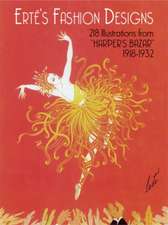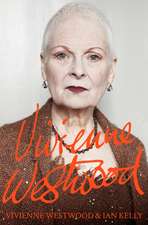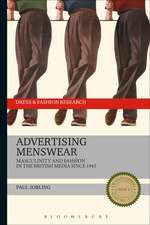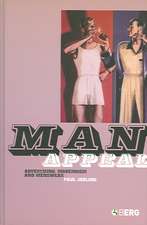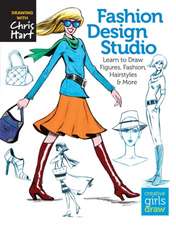Fashion, Identity, Image
Autor Paul Jobling, Philippa Nesbitt, Angelene Wongen Limba Engleză Paperback – 4 mai 2022
| Toate formatele și edițiile | Preț | Express |
|---|---|---|
| Paperback (1) | 152.73 lei 3-5 săpt. | +26.41 lei 7-11 zile |
| Bloomsbury Publishing – 4 mai 2022 | 152.73 lei 3-5 săpt. | +26.41 lei 7-11 zile |
| Hardback (1) | 436.46 lei 3-5 săpt. | +42.19 lei 7-11 zile |
| Bloomsbury Publishing – 4 mai 2022 | 436.46 lei 3-5 săpt. | +42.19 lei 7-11 zile |
Preț: 152.73 lei
Preț vechi: 166.04 lei
-8% Nou
Puncte Express: 229
Preț estimativ în valută:
29.23€ • 29.93$ • 24.31£
29.23€ • 29.93$ • 24.31£
Carte disponibilă
Livrare economică 25 februarie-11 martie
Livrare express 11-15 februarie pentru 36.40 lei
Preluare comenzi: 021 569.72.76
Specificații
ISBN-13: 9781350183209
ISBN-10: 1350183202
Pagini: 176
Ilustrații: 40 colour illus
Dimensiuni: 156 x 234 x 11 mm
Greutate: 0.32 kg
Editura: Bloomsbury Publishing
Colecția Bloomsbury Visual Arts
Locul publicării:London, United Kingdom
ISBN-10: 1350183202
Pagini: 176
Ilustrații: 40 colour illus
Dimensiuni: 156 x 234 x 11 mm
Greutate: 0.32 kg
Editura: Bloomsbury Publishing
Colecția Bloomsbury Visual Arts
Locul publicării:London, United Kingdom
Caracteristici
A timely and probing consideration of the impact of marginalised and non-binary groups on fashionable identities, embracing queer and trans activism, biotechnologies and trans-species engineering, and the longevity revolution, the ageing body and memory.
Notă biografică
Paul Jobling is the author of Fashion Spreads (Berg, 1999), Man Appeal (Berg, 2005) and Advertising Menswear (Bloomsbury, 2014). He was Visiting Professor between 2018 and 2020 for the MA Fashion Studies at The New School, Parsons Paris, France.Philippa Nesbitt graduated from the MA Fashion Studies, The New School, Parsons Paris. Her MA thesis explores the emergence and impact of gender non-conformativity in global fashion modelling and media. She is currently digital curator for Revue magazine.Angelene Wong graduated from the MA Fashion Studies, The New School, Parsons Paris. She is a doctoral student at School of Art, Design and Media at Nanyang Technological University, Singapore, and a dance artist. Her doctoral thesis focusses on body politics at the intersection of fashion media, dance, and digitalisation.
Cuprins
List of Illustrations AcknowledgementsIntroduction1. Authoring Fashion, Intersecting Sex and GenderIntroduction Maria Grazia Chiuri's 'We Should All Be Feminists' T-Shirt for Christian Dior: Branding, identity and authorshipBetween the womb and the gay parade: Alexander McQueen's 'The Widows of Culloden' as poetic textSubverting the symbolic order: McQueen's abject womanConclusion: Squaring up to the phallic motherNotes2. Written on the body: Fashion, clothing and ageIntroduction'Active ageing', youthfulness and fashion'Fashion For All Ages' and the new old model armyRace and reversing conventionConclusion: From idiotic methods to the realities of time and placeNotes3. (Un)Gendering the runwayIntroductionForerunners of transgender and non-binary identities in fashionThe advent of transgendered modelsThe abject trans-modelBetween abjection and acceptance'Come into the (trans)garden': The heterotopia of fashionThe authentic selfOther models: Intersectionality and wider diversity in the fashion industryTokenism versus activismConclusion: Between tokenism and authenticity Notes 4. Loving the alien: Fashion and cyborg identitiesIntroduction Andrea Giacobbe and 'Simplex Concordia' Alessandro Michele and the Gucci Cyborg Compromising race and diversity A 'genuine cyborg manifesto'? Conclusion: Towards emancipatory possibilities Notes Epilogue
Recenzii
Gives currency to the importance of fashion as an arbiter of change at a time when the multiplicity and fragmentation of gender is affecting the ways we perceive and experience our bodies and our identities. Its contents will incite ideas and heated debates and I am sure it will be a book whose pages will be well-thumbed and whose subject matter will make for long and passionate arguments and conversations.
Utilizing recent and historic examples, the authors offer a robust account of the role of the fashion industry in creating age, race, gender, and posthuman identities, both actual and fantastic. I finished this book with inspiration for my teaching and research.
Utilizing recent and historic examples, the authors offer a robust account of the role of the fashion industry in creating age, race, gender, and posthuman identities, both actual and fantastic. I finished this book with inspiration for my teaching and research.
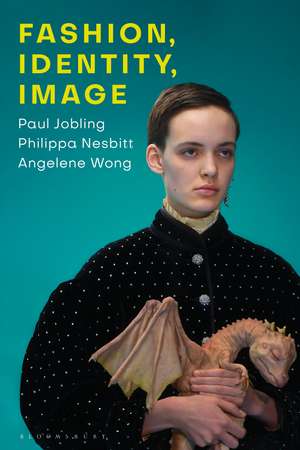
![Patternmaking for Fashion Design [With DVD ROM]](https://i1.books-express.ro/bt/9780135018767/patternmaking-for-fashion-design-with-dvd-rom.jpg)
